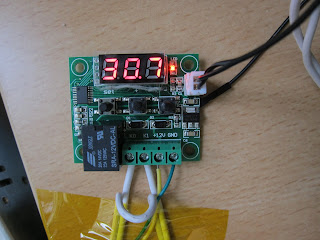Hephestos 2 heated bed
Since I got a beta version of Hephestos 2 from BQ before its launch, I have been using that printer more and more. After the initial annoyance about doing things on a certain way (like heating the extruder before performing a home move on an axis) I have got used to these details and I do not care anymore.
And with a few exceptions were a part bottom failed to stick to the bed (nothing that a bit of hairspray could not fix) the printer has been delivering consistently quality prints. Z-axis became a bit noisy on long moves but I have no other complaints.
However, all the time I have been using PLA or Filaflex on a cold bed. There is no provision for a heated bed add-on so I had a look around for a stand-alone temperature controller. I have found a simple pcb unit with display that controls a relay for a heating load up to 20A. Not sure how long that relay could last but for less than $5 I am going to give it a try.
And with a few exceptions were a part bottom failed to stick to the bed (nothing that a bit of hairspray could not fix) the printer has been delivering consistently quality prints. Z-axis became a bit noisy on long moves but I have no other complaints.
However, all the time I have been using PLA or Filaflex on a cold bed. There is no provision for a heated bed add-on so I had a look around for a stand-alone temperature controller. I have found a simple pcb unit with display that controls a relay for a heating load up to 20A. Not sure how long that relay could last but for less than $5 I am going to give it a try.
Next the bed, I do like aluminium beds with power resistors epoxied to the bottom. In this case care is needed to take advantage of the holes in the bed holder parts so that space could be used by the resistors without losing more than a few millimetres of print height.
Just for testing I fixed the bed using kapton tape. I was not sure on whether to use the same clamp mechanism used for the standard bed, so I reckon I will use metal bulldog clips on the sides. This new bed being metallic too works ok with the inductive probe used for automatic bed tramming.
The only other change needed was to adjust the bed offset for the new bed before starting to print. Next PLA printing at 50C worked without any trouble.
And so did the first sample print I did on ABS. But I have to kill that after a few layers because the bed was wobbling back and forth as only a bit of kapton tape was fixing it to the bed holder. Next day I will fix the bed properly to the carriage.
Of course for this bed, equipped with 4 25W power resistors, and disipating around 120W an additional power supply is needed. I used a 12V 300W power supply I had around. 12V are needed to power the temperature controller and I am using 12V for the heating element too.
No electrical or logical connection with the Hephestos 2 electronics is needed. Of course that also means that nor the printer nor the host software has a way to switch on or off the bed or of adjusting the temperature. All of this has to be done manually by the user.







Comments
http://forum.seemecnc.com/viewtopic.php?t=7452
thank you so much
continue to use this method?
continue to use this method?
in k0 and k1 you connect the power adapter? how you set the thermistor to the aluminum plate.
I also use abs with another printer and for the use of the PLA 2 hephestos but sometimes if the piece is big I is separated from the plate and do not know how to fix it :(